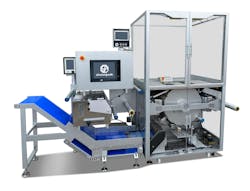Riverside Medical Packaging Co. Ltd., the manufacturer of Shawpak thermoforming machines, during the height of the COVID-19 pandemic last year introduced what it calls a “fully integrated” system for automated packaging of medical devices.
The turnkey solution features the company’s thermoforming machine, a robot to load the injection molded devices into it, inline printing of the packaging and visual inspection of the goods.
Shawpak thermoforming machines, introduced about four years ago, feature a unique compact design for producing both flexible and rigid blister packages. Riverside Medical Packaging, headquartered in Derby, England, manufactures blister packs and developed the thermoforming machines for its own use. It now sells the equipment to other packaging companies.
A U.S. customer approached the company last year wanting to purchase 10 systems for packaging medical devices in high demand due to the pandemic, according to the company. Shawpak built the system around its standard 32-20 rotary machine. Each model of its machines is named according to the measurement, in centimeters (cm), of its maximum web width and maximum index distance — so the 32-20 has a maximum web width of 32 cm, or about 12.6 inches, and a maximum index of 20 cm, or about 7.9 inches.
However, the new fully integrated system also includes an inline thermal transfer printer, a vision inspection and rejection system, and robot loading of injection molded medical devices into the thermoforming machine. Shawpak uses third-party manufacturers for those integrated products, and customers can select the specific manufacturers and models they wish to incorporate, said Tony Crofts, Shawpak’s sales and marketing director.
Shawpak also incorporates a multi-lane slitter that slits or perforates the packs containing the individual devices after they are formed and sealed. The entire system’s footprint is about 4 feet wide by 6.5 feet long.
“Being so compact with a small footprint, it is easy to move and free up space in high-cost production environments,” the company said.
The system can produce up to 7,000 blister packs per hour with Shawpak’s rotary drum thermoforming technology, the company said.
“When we first started selling the machines, they were just manually loaded with pre-printed films,” said Bob Hartwig, managing director of BTS International LLC, which represents Shawpak in North America. Shawpak has also done business under the name SP Thermoforming. “And now, with the request we had from this particular COVID application and others, we’ve developed this new fully functional version. It’s a little bit bigger, but it’s still only about 6 feet long, which is less than half the size of a traditional linear thermoformer.”
A traditional thermoforming line is anywhere from 10 to 30 feet long with multiple stations where different operations are performed as the web is carried through the machine. However, Shawpak developed a system using a vertical carousel.
“Instead of progressing from left to right or right to left, now the machine utilizes a vertical carousel,” Hartwig said. “We are basically feeding the raw film in at three o’clock and forming there; we’re loading at 12 o’clock; we’re sealing at 9, and then we do any cross cutting and perforations and things like that around 7:30, and at 6 o’clock it gets removed from the drum. This means we have a significantly smaller footprint.”
Minimizing space can be essential with medical devices because space inside clean rooms is “a very expensive real estate zone,” Hartwig said.
“We’ve tried to minimize not only the space, but the cost, especially for the maintenance of these machines, to dramatically change the way blisters are vacuum formed,” Hartwig said.
Shawpak’s carousel design allowed the company to eliminate clip chains, vacuum pumps and chillers.
“There’s no vacuum pump because we form with a patented system that uses reversing air pressure,” Hartwig said. “There's no chiller because we’re only heating the areas where the cavities are … In addition to that, we only need single-phase power because we utilize stepper motors instead of servos.”
Product changeovers are fast and easy, typically ranging from five to 20 minutes, he said.
The Shawpak 32-20 rotary machine in the new thermoforming system has a forming area for the blister packs of 12.6 inches by 7.9 inches. However, the system also could be built using larger thermoforming machines with forming areas as large as 24.4 inches by 9.8 inches, Hartwig said.
Shawpak rotary thermoformers are available in eight machine sizes and require a low capital cost — about 30 percent to 40 percent less than traditional machines.
Bruce Geiselman, senior staff reporter
BTS International LLC, Franklin Lakes, N.J., 201-961-4740, www.shawpak.co.uk
About the Author
Bruce Geiselman
Senior Staff Reporter Bruce Geiselman covers extrusion, blow molding, additive manufacturing, automation and end markets including automotive and packaging. He also writes features, including In Other Words and Problem Solved, for Plastics Machinery & Manufacturing, Plastics Recycling and The Journal of Blow Molding. He has extensive experience in daily and magazine journalism.
